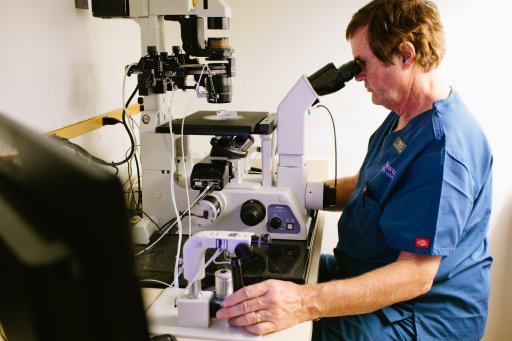Assisted Reproductive Technologies (ART)
Assisted Reproductive Technologies, or ART, simply refers to any fertility-assistance technique in which both the egg and sperm are handled. Perhaps the best-known ART is In Vitro Fertilization, but there are several others that may sometimes be appropriate depending on your unique needs:
-
- Intracytoplasmic Sperm Injection (ICSI). During an IVF cycle it may be necessary to perform other assisted reproductive technologies to facilitate implantation. Intracytoplasmic Sperm Injection (ICSI) procedure is performed in cases of severe male factor infertility. The embryologist microscopically identifies a normal appearing, active sperm and will directly inject this single sperm into an egg that has been retrieved. This technique is used when the man has a very low sperm count; a low number of normal-shaped sperm; or when sperm is retrieved from the epididymis or testis.
-
- Assisted Hatching (AH) is a microscopic procedure performed by the embryologist. The outer “shell” of the embryo is made of a thick protein and is called the zona pellucida. In order for implantation to take place, the zona pellucida begins to “hatch” or break down so that the embryo can furrow itself into the lining of the uterus and establish a physical connection with the mother. Assisted hatching facilitates this process. The embryologist microscopically “thins” the outer protein shell in order to assist the embryo’s hatching and implantation process. The decision to perform Assisted Hatching is based on the thickness of the zona pellucida, the number of cells present in the embryo, the degree of fragmentation within the embryo and the age of the woman.
-
- Pre-Implantation Genetic Diagnosis (PGD) is a set of procedures that are performed on embryos prior to implantation, sometimes even on oocytes prior to fertilization. PGD is considered another way to prenatal diagnosis. Its main advantage is that it avoids selective pregnancy termination as the method makes it highly likely that the baby will be free of the disease under consideration. PGD thus is an adjunct to assisted reproductive technology, and requires in vitro fertilization (IVF) to obtain oocytes or embryos for evaluation.
-
- Frozen Embryos. The nature of in vitro fertilization creates a situation where several embryos are created. To transfer all of these embryos may be unhealthy and very risky for complications in both the mother and babies. To avoid this high risk pregnancy, only one to three embryos are transferred to the woman’s uterus. This leaves viable embryos in the laboratory. These embryos undergo a specialized “freezing” process and these frozen embryos are then stored in the laboratory. The frozen embryos remain in storage until the couple is ready to undergo another embryo transfer. During a frozen embryo transfer cycle, the woman’s uterus is hormonally prepared for implantation. Once the lining of the uterus has developed adequately, the embryos are thawed and then transferred to the woman’s uterus. The woman continues to take these hormones until the placenta takes over the hormone production that is necessary for maintaining the pregnancy. The pregnancy continues to develop just like any other pregnancy.
-
- Sperm Retrieval (TESA and PESA). A man may have physiological or anatomical condition that prevents the passage of sperm. The condition may include a congenital absence of the vas deferens; a prior infection that has caused a blockage; decreased testicular functioning that causes a low sperm count. This man’s sperm may be retrieved from his epidydimis, vas deferens or testicular tissue. When the sperm are retrieved from the epididymis the procedure is called Percutanous Epididymal Sperm Aspiration (PESA). If the sperm are retrieved from the testicle it is called Testicular Sperm Extraction (TESE). Using the sperm that the urologist has retrieved is then passed to the embryologist and an ICSI procedure is performed.
Call 602-956-7481 to speak with a Fertility Specialist today about all available assisted reproductive technologies fertility treatment options.


